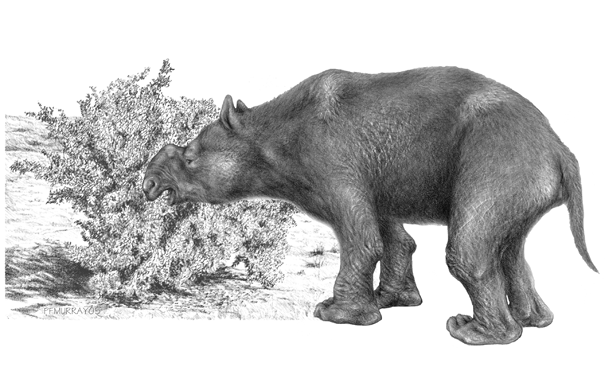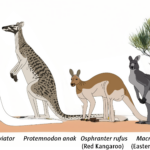
An extinct marsupial mega-herbivore, Diprotodon optatum. Drawing by Peter Murray/Image © Science/AAAS
New state of the debate: Australian megafauna hunted to extinction.
Scientists have provided new evidence for the theory that human hunters were primarily responsible for the disappearance of the megafauna about 40,000 years ago. The researchers also concluded that the extinction caused changes to the Australian landscape.
The scientists analysed Sporormiella spores in Pleistocene-age herbivore dung from two sediment cores from tropical Australia, and determined that the megafauna had virtually disappeared 41,000 years ago. “The timing of this decline agrees closely with estimates of the date of megafaunal extinction from fossil evidence elsewhere in Australia,” the authors wrote in the paper published in Science.
They suggest that humans, who arrived in Australia around this time, were the cause of the megafaunal extinction rather than climate, as no known climate transformations were occurring at the time.
The disappearance of the megafauna would also have had a significant impact on the Australian ecology, according to lead author Chris Johnson, from The University of Tasmania. “Big animals have big impacts on plants. It follows that removing big animals should produce significant changes in vegetation.”
By examining the changes in pollen and charcoal remnants, the authors also detected a transition from mixed rainforest to leathery-leaved, scrubby vegetation and an increase in fire activity. However, these changes to the landscape took place after the animals died out, indicating that they were the result of the extinction and not its cause.
Independent expert Dr Gavin Prideaux, from Flinders University, said the research is an important contribution to our understanding of what happened some 40,000 years ago, when 90 per cent of Australia’s large terrestrial species disappeared. “The timing of the inferred extinction coincides with early human presence in the region, but not with significant climatic change… This supports a mounting number of studies that have argued that climate change was not primarily responsible for the Late Pleistocene extinctions in other parts of the continent.”
But not everyone agrees with these results. Dr Judith Field, from The University of New South Wales, said the interpretations drawn from these results are unsubstantiated and can be explained by other mechanisms. “To assert that these changes came after faunal extinctions is not supported by the data- the assumed proxies are not demonstrated.”
She also said most megafauna were extinct nearly 100,000 years before human arrival. “The only evidence we have from Queensland for megafauna indicates that they were gone before humans arrived.”
Source: AUSSMC






